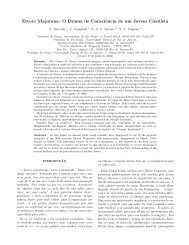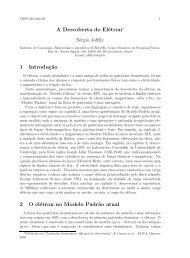Expoente de Lyapunov para um Gás de Lennard–Jones - CBPFIndex
Expoente de Lyapunov para um Gás de Lennard–Jones - CBPFIndex
Expoente de Lyapunov para um Gás de Lennard–Jones - CBPFIndex
Create successful ePaper yourself
Turn your PDF publications into a flip-book with our unique Google optimized e-Paper software.
Apêndice D<br />
Função <strong>de</strong> distribuição radial<br />
Neste apêndice trataremos dos métodos empregados nos cálculos das médias <strong>de</strong> ensemble<br />
realizados no corpo da dissertação. As referências principais utilizadas foram o livro <strong>de</strong><br />
Balescu [56] e <strong>de</strong> Hill [54].<br />
D.1 Função <strong>de</strong> distribuição reduzida<br />
Inicialmente consi<strong>de</strong>remos <strong>um</strong>a função dinâmica arbitrária b, <strong>de</strong> <strong>um</strong> sistema <strong>de</strong> N partículas<br />
idênticas e sem estrutura, <strong>de</strong>pen<strong>de</strong>nte das 6N variáveis canônicas, isto é:<br />
b = b (q1, p1, . . ., q3N, p3N) = b (r1,p1, . . .,rN,pN) (D.1)<br />
Vamos agora introduzir a seguinte notação combinada:<br />
xi = (ri,pi)<br />
Observar a diferença com a notação utilizada no capítulo 2; aqui também não será necessário<br />
pensarmos matricialmente. Conseqüentemente, a equação (D.1) fica:<br />
b = b (x1, . . .,xN)<br />
Para <strong>um</strong> sistema constituído <strong>de</strong> N partículas idênticas, b é <strong>um</strong>a função simétrica com<br />
respeito à permutação <strong>de</strong> qualquer par <strong>de</strong> partículas:<br />
b (x1, . . .,xj, . . .,xk, . . .,xN) = b (x1, . . .,xk, . . . ,xj, . . . ,xN)<br />
Funções dinâmicas com esta característica, em verda<strong>de</strong>, são as únicas que possuem relevância<br />
física, além <strong>de</strong> po<strong>de</strong>rem ser escritas, <strong>de</strong> forma unívoca, da seguinte maneira:<br />
b = b0 +<br />
N<br />
i =1<br />
N−1 <br />
b1 (xi)+<br />
i = 1 j > i<br />
N<br />
N−s <br />
b2 (xi,xj)+··· +<br />
113<br />
j1 = 1<br />
<br />
· · ·<br />
N−s+1<br />
j2 > j1<br />
N<br />
js > js−1<br />
bs (xj1,xj2, . . .,xjs) +<br />
+ · · · + bN (x1, . . .,xN) (D.2)
















